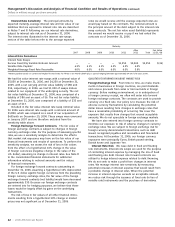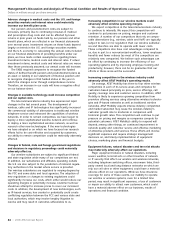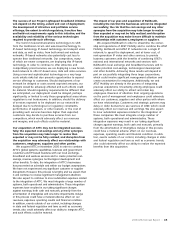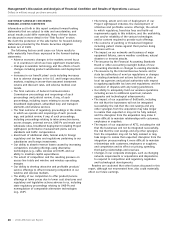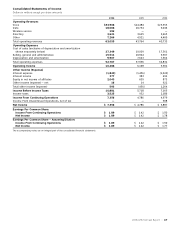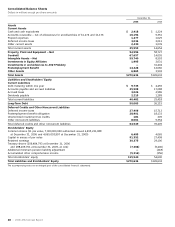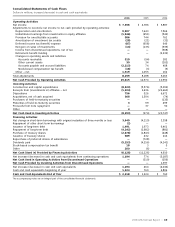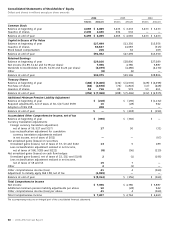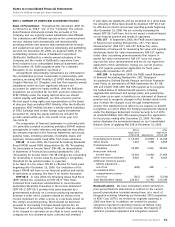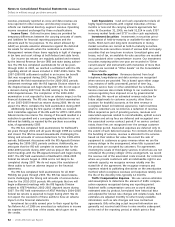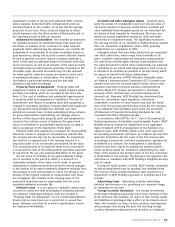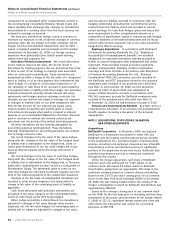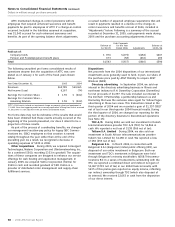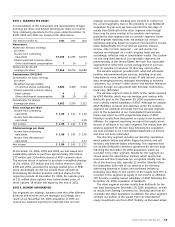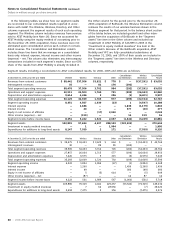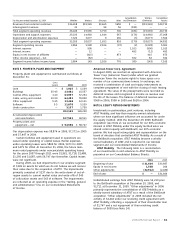AT&T Wireless 2006 Annual Report Download - page 54
Download and view the complete annual report
Please find page 54 of the 2006 AT&T Wireless annual report below. You can navigate through the pages in the report by either clicking on the pages listed below, or by using the keyword search tool below to find specific information within the annual report.
52 : :
2006 AT&T Annual Report
Notes to Consolidated Financial Statements (continued)
Dollars in millions except per share amounts
revenue, previously reported as voice and data revenue are
now reported in other revenue; and directory revenue now
reflects our traditional directory segment revenue. Operating
income remained unchanged by these reclassifications.
Income Taxes Deferred income taxes are provided for
temporary differences between the carrying amounts of assets
and liabilities for financial reporting purposes and the
amounts used for tax purposes. To the extent allowed by
GAAP, we provide valuation allowances against the deferred
tax assets for amounts when the realization is uncertain.
Management reviews these items regularly in light of changes
in tax laws and court rulings at both federal and state levels.
Our income tax returns are regularly audited and reviewed
by the Internal Revenue Service (IRS) and state taxing authori-
ties. The IRS has completed examinations for all tax years
through 2002. In 2005, we reached a settlement with the IRS
regarding almost all issues included in 1997-1999 claims. The
1997-1999 IRS settlement resulted in an income tax benefit
that was recognized during 2005. During 2006 the IRS
completed the field examination for the 2000-2002 periods.
Settlement meetings with the IRS Appeals Division related to
the disputed issues will begin during 2007. We do not expect
a decision during 2007 from the IRS relating to the 2000-
2002 disputed issues. The completion of the 2000-2002
examination is not expected to have an adverse impact on the
financial statements. The IRS also began its field examination
of our 2003-2005 federal tax returns during 2006. We do not
expect the IRS to complete the field examination during 2007.
Additionally, during the first quarter of 2006, we received
Joint Committee approval of the IRS audit for ATTC’s 1997-2001
federal income tax returns. The closing of this audit resulted in a
reduction to goodwill and a corresponding reduction in our net
deferred tax liability, as required by the purchase accounting
rules, of approximately $385.
The IRS has completed field examinations for BellSouth’s
tax years through 2001 and all years through 1998 are settled
and closed. The IRS has issued assessments challenging the
timing and amounts of various deductions for the 1999-2001
periods. Settlement discussions with the IRS Appeals Division
regarding the 1999-2001 periods continue. Additionally, we
anticipate that the IRS will complete its examination for the
2002-2003 periods during 2007 and we project that settle-
ment meetings with the IRS Appeals Division will begin during
2007. The IRS’ field examination of BellSouth’s 2004-2005
federal tax returns began in 2006 and is not likely to be
completed during 2007. We do not expect the resolution of
these audits to have an adverse impact on the financial
statements.
The IRS has completed field examinations for all AT&T
Mobility tax years through 2003. The IRS has issued assess-
ments challenging the timing and amounts of various deduc-
tions for the 2002-2003 periods. We anticipate that we will
begin settlement meetings with the IRS Appeals Division
related to AT&T Mobility’s 2002-2003 disputed issues during
2007. The IRS’ field examination of AT&T Mobility’s 2004-2005
federal tax returns is expected to begin during 2007. We do
not expect the resolution of these audits to have an adverse
impact on the financial statements.
Investment tax credits earned prior to their repeal by the
Tax Reform Act of 1986 are amortized as reductions in income
tax expense over the lives of the assets, which gave rise to
the credits.
Cash Equivalents Cash and cash equivalents include all
highly liquid investments with original maturities of three
months or less and the carrying amounts approximate fair
value. At December 31, 2006, we held $1,324 in cash, $357
in money market funds and $737 in other cash equivalents.
Investment Securities Investments in securities princi-
pally consist of held-to-maturity or available-for-sale instru-
ments. Short-term and long-term investments in money
market securities are carried as held-to-maturity securities.
Available-for-sale securities consist of various debt and equity
securities that are long term in nature. Unrealized gains and
losses, net of tax, on available-for-sale securities are recorded
in accumulated other comprehensive income. Our investment
securities maturing within one year are recorded in “Other
current assets” and instruments with maturities of more than
one year are recorded in “Other Assets” on the Consolidated
Balance Sheets.
Revenue Recognition Revenues derived from local
telephone, long-distance and data services are recognized
when services are provided. This is based upon either usage
(e.g., minutes of traffic processed), period of time (e.g.,
monthly service fees) or other established fee schedules.
Service revenues also include billings to our customers for
various regulatory fees imposed on us by governmental
authorities. We record an estimated revenue reduction for
future adjustments to customer accounts, other than a
provision for doubtful accounts, at the time revenue is
recognized based on historical experience. Cash incentives
given to customers are recorded as a reduction of revenue.
When required as part of providing service, revenues and
associated expenses related to nonrefundable, upfront service
activation and set-up fees are deferred and recognized over
the associated service contract period. If no service contract
exists, those fees are recognized over the average customer
relationship period. Associated expenses are deferred only to
the extent of such deferred revenue. For contracts that involve
the bundling of services, revenue is allocated to the services
based on their relative fair value. We record the sale of
equipment to customers as gross revenue when we are the
primary obligor in the arrangement, when title is passed and
the products are accepted by customers. For agreements
involving the resale of third-party services in which we are not
considered the primary obligor of the arrangement, we record
the revenue net of the associated costs incurred. For contracts
where we provide customers with an indefeasible right to use
network capacity, we recognize revenue ratably over the
stated life of the agreement. We recognize revenues and
expenses related to publishing directories on the amortization
method, which recognizes revenues and expenses ratably over
the life of the directory title, typically 12 months.
Traffic Compensation Expense We use various estimates
and assumptions to determine the amount of traffic compen-
sation expenses recognized during any reporting period.
Switched traffic compensation costs are accrued utilizing
estimated rates by product, formulated from historical data
and adjusted for known rate changes and volume levels. Such
estimates are adjusted monthly to reflect newly available
information, such as rate changes and new contractual
agreements. Bills reflecting actual incurred information are
generally not received until three to nine months subsequent
to the end of the reporting period, at which point a final


